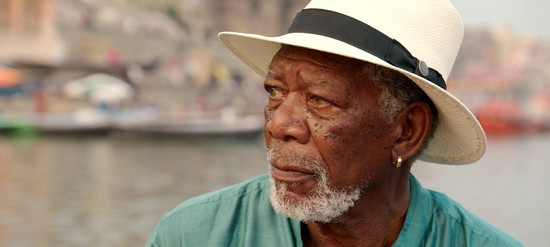Morgan Freeman has played god twice, and offered up a godlike voice in countless narrations, but those gigs aren't what inspired him to serve up an almighty story.
Instead, the Academy Award-winning actor visited a mosque where he found an image of Jesus Christ. The realization that Islam recognizes Jesus as a prophet sent Freeman through a figurative wormhole on a religious exploration, and expedition.
In his new National Geographic Channel series, The Story of God with Morgan Freeman, premiering April 3 at 9 p.m., the actor embarks on a spiritually curious journey to 20 countries with the big questions on his mind about life, the universe, and everything. More specifically, episodes tackle topics such as the afterlife, end of days, creation, miracles, evil, and a biggie: Who is is God? The sensitive but secular travelogue shows him learning about major world belief systems, and discovering where they connect and diverge.
Instead of skewing towards Christianity (or targeting Christians specifically by, for instance, debuting last week as part of Easter programming), the series -- executive produced by Freeman and his Revelations Entertainment company with Lori McCreary and James Younger -- strives to remain well rounded and representative. It is a laudable mission in an environment of heated rhetoric driven by those who wish to squash notions of religious unity.
Based on my own observations and recent travels, it strikes me that the city of Rome seems to have something of a spiritual bond with Story of God. It makes an appearance multiple times during the series, and the dynamic culture of Rome accentuates the theme of connectivity through belief - when you take a closer look -- on display in the show. In fact, last month I joined a tour of the religious institutions of Italy's capital, and looking back, I've gained a sense of Freeman's purpose.
While Rome is home to the papal enclave of Vatican City, the headquarters of the Catholic Church, the city once hosted a pantheon of gods. And the evidence of those old beliefs is still clearly on display alongside comparatively new churches. (The first century La Bocca della Verità, or "Mouth of Truth" on display in the portico of the Basilica of Saint Mary in Cosmedin, and assigned magical properties in the Middle Ages, being one of my favorite examples of this relationship.) But the city also has a vibrant Jewish population, as well as a growing Muslim community, and Hindu practitioners.
It would be easy to go to Rome and on a mission to explore religion, and only talk about the Catholic Church. As of 2010, more than 80 percent of Italy's population is Catholic, according to the Pew Research Center. And, for my first time inside, the site lived up to the hype. Saint Peter's Basilica was as awe-inspiring, and the Sistine Chapel as stunning, as I'd hoped; and it became understandable how the study of the theology, artistry, and politics of the Vatican has consumed the entire lives of countless academics.
Plus, the popular Pope Francis is totally having a moment right now.
Freeman certainly explores these avenues. In the third episode, "Creation," he heads to the Vatican and meets with Archbishop Marcelo Sánchez Sorondo, chancellor of the Pontifical Academy of Sciences. The ensuing conversation is a fascinating one wherein Sorondo details his belief that faith and science can be complementary, not mutually exclusive.
During my time in Rome, I visited the old Jewish ghetto, which was a gated area control by the papacy between 1555 and 1870. The Jewish community of Rome, 14,000 strong, has seen triumph and tragedy throughout the years. After first entering the area in 161 B.C.E., the community has remained constant. Over time, Jews were forced to either work as money lenders or buyers and sellers of used clothes. Throughout the years they were accused of killing Christ (an accusation only officially abandoned by the Catholic Church in 1965), and forced to listen to religious sermons meant to convert them to Christianity. And during the Nazi occupation of World War II, 2,000 of the 10,000 Roman Jews were killed - and those victims of the Holocaust are remembered within the ghetto in the form of cobblestone plaques, or stumbling stones, laid in the ground.
The Great Synagogue of Rome, was completed in 1904, after the unification of Italy and dissolution of the ghetto. One of 18 synagogues in Rome, as opposed to about 600 churches, it is built in the ornate Italian tradition, and stands as a point of pride for Roman Jews. It is also a reminder of improving relations between Catholicism and Judaism; Pope John Paul II visited the synagogue in 1986, which marked the first time a pope had visited one since the Church's early beginnings. Pope Benedict XVI and Pope Francis have also visited the Great Synagogue.
Although Freeman doesn't visit this particular synagogue, it occupies an important space within the spirit of the show as a significant site co-existing alongside the Catholic Church. The same is true for the Mosque of Rome, the largest of its kind in the Western world.
Only inaugurated about 21 years ago, the structure is built on land donated by the city council, and the project was given the blessing of Pope John Paul II. In a country dominated by Catholicism, it is nonetheless a massive landmark that can cater to more than 12,000 people. The mosque - peaceful with warm sunlight bathing the interior -- incorporates both traditional Roman and contemporary architecture. Located in the neighborhood of Parioli, the mosque serves as a place for Muslims to gather, but is also very much an important part of Rome.
Once again, the theme here is it is there are more ties that bind than separate us, when we want to look. And that's something Freeman accomplishes rather adroitly in the various topics he tackles.
Moreover, beyond limiting his mission to currently active belief systems or contemporary doctrines, Freeman also explores the past.
Whether it is an ancient Mayan sacrificial wells where blood was literally spilled, an Egyptian pharaohs tomb, or the playing fields of Rome's Circus Maximus where brutal sports were played, the series through line is humanity is often bound as much by the differences of our beliefs as the stark similarities.
Though I view it through the lens of recent travels, one doesn't need to visit Rome to appreciate the point of The Story of God With Morgan Freeman. The ambitious show is an exploration of global proportions. It is not intended to instill belief, and avoids promoting a "true" religion. Instead, it is a travelogue of ideas as well as places.
It encourages understanding, and does so by bringing almighty questions down to a human perspective, and stirs conversation through connection.

